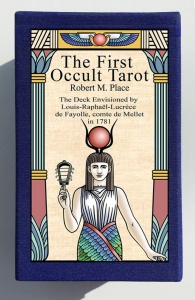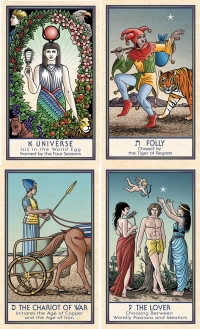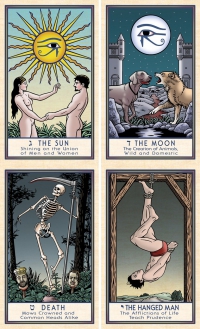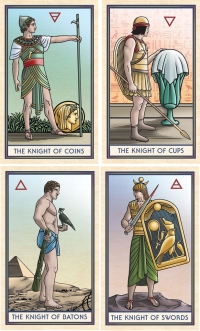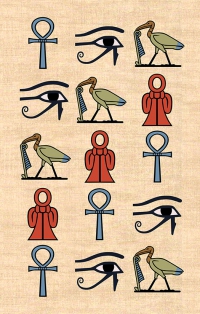塔羅牌 > 獨立作家及限量版
The First Occult Tarot
作者 : Robert M. Place出版社/廠商 : Self-Publish
價格: $880 HKD
貨品編號: 11519
貨品介紹:
本產品需要付全數訂金訂貨,一般需時約 2-4 星期到貨。Before Aleister Crowley, before Arthur Edward Waite and Pamela Colman Smith, before the Golden Dawn, before Papus, Éliphas Lévi, and Etteilla, the first author to describe an occult version of the Tarot was Louis-Raphaël-Lucrèce de Fayolle, comte de Mellet, writing in Antoine Court de Gébelin’s, 1781, eighth volume of his monumental encyclopedia, Monde primitif.
The comte de Mellet associated the Tarot’s trumps with the Classical Ages of Man: the Age of Gold, the Age of Silver, and the Age of Iron. He correlated the Trumps with the letters in the Hebrew alphabet, he described the minor suits in detail, and he provided the earliest discussion of a divination technique for the Tarot. Now for the first time de Mellet’s vision for the Tarot exists as a complete deck, and book: The First Occult
More details of the deck
Anyone knowledgeable about Tarot history knows that the first occultist to write about the Tarot was the Parisian Freemason Antoine Court de Gébelin. In 1781 he published the eighth volume of his occult encyclopedia, Monde Primitif, and starting on page 365, he included an article on the Tarot in which he put forth his theories on the origin and meaning of the Tarot’s trumps and minor suits. De Gébelin theorized that the Tarot was a series of hieroglyphs that originated in ancient Egypt, were passed onto ancient Rome, and from there to France and Germany.
His article was accompanied by a series of engravings created by Mademoiselle Linote, who died the same year that they were published. Her illustrations are sketchy copies of a standard set of trumps from a French Tarot of Marseille, most likely the Conver Tarot, from 1760. De Gébelin added titles to them that suggested what they might have signified in Egyptian culture.
The Fool retains his name, but his dog is interpreted as a tiger, and in Linote’s engraving the animal does look like a cat but with spots, not stripes. It seems that Court de Gébelin was not distinguishing between a tiger, a cat that does not live in Africa, and a leopard, a cat that does. Trump One is the Juggler or Cup-Player, who is said to be holding the wand of Jacob or of the Magi.
After de Gébelin’s article in Monde Primitif, he placed another article composed by the Comte de M, identified as Comte de Mellet. Comte de Mellet’s theories differ from de Gébelin’s on several points. From this, we may assume that Court de Gébelin did not feel that his theory was the final word, and he wanted to present other possibilities. For example, while de Gébelin believed that Tarot meant “the Royal Road” in Egyptian, de Mellet makes the case that the Tarot is actually the mystical Book of Thoth. He theorizes that the name Tarot is derived from the Egyptian Ta Rosh, which he said means the science of Thoth or Mercury, a possible reference to alchemy. He says that the book or deck was brought from Egypt to Spain by the Arabs, and from there, the soldiers of the Holy Roman Emperor Charles V carried it to Germany in the 16th century. He suggests a relationship between the twenty-two letters of the Hebrew alphabet and the Fool and the twenty-one trumps. He discusses the meaning of several of the pip and court cards and demonstrates the use of the deck for divination.
But his discourse on the trumps stands out the most, because it is more coherent and presents a unified approach that unites the trumps in one continuous narrative. Most scholars agree that the de Mellet article is older and most likely influenced de Gébelin. Not only is it older, but it is more complete and effectively it is the first description of a recreated occult Tarot deck. Therefore, we may call it the “first occult Tarot.”
As we look at the details that de Mellet describes, it is clear that he is not describing the Tarot of Marseille but he is describing the Besançon Tarot, which was first carved by Francois Isnard (1695 – 1765), who lived in Strasburg, France. The deck became popular in South Eastern France, Switzerland, and parts of Germany. De Mellet clearly describes cards that only appear in the Besançon, such as Jupiter with his eagle instead of the Pope for the fifth trump and Juno with her peacock instead of the Papesse for the second trump. We will see other similarities as we go over his discourse.
Comte de Mellet interpreted the trumps as a Hermetic text describing the creation of the world in three stages. Starting with the World trump and working backwards, because he claimed that the Egyptians read from right to left, he divided the trumps into three groups of seven and related each group to one of the Classical Ages: the Age of Gold, the Age of Silver, and the Age of Iron. There are actually four Classical Ages, but de Mellet has combined the Age of Bronze the Age of iron into one for his discourse.
The Age of Gold begins with Trump Twenty-one, the World or the Universe, depicting Isis in the center of the egg of time with the symbols of the four seasons in the corners. Then comes Judgement, depicting Osiris creating humans from Earth.
Who was the comte de Mellet?
Louis-Raphaël-Lucrèce de Fayolle, comte de Mellet, was born in 1727 in Périgueux, a city in the region of Nouvelle-Aquitaine, in southwestern France. His was a noble family and he inherited the title of chevalier (knight) along with extensive holdings of land and wealth. Later, his title was elevated to comte (count) as a reward for his service to the king. De Mellet’s military career included service as a musketeer, the chief of the corps of bodyguards for the king of Poland, knight of the Order of Saint Louis, officer of the corps of bodyguards for the king of France, governor of the French provinces of Maine and Perche, lieutenant general of the king’s armies, and field marshal to the king himself. The count was married to Élizabeth-Mélanie le Daulceur in 1763 and they had five children. When the French Revolution broke out in 1789, as an avid supporter of the king, de Mellet was compelled to flee the country. He went to Germany and his lands were confiscated, he died in1804. (Vine, 146-148)
De Mellet had been a subscriber to de Gébelin’s Monde primitif at least since the publication of the third volume, in 1775. At that time, he began corresponding with deGébelin when he wrote to the esteemed savant to debate an issue on grammar. It seems that de Mellet’s maternal uncle, Henri-Léonard-Jean-Baptiste Bertin (1717-1794), may have provided the introduction to de Gébelin. Bertin was also a subscriber. Presumably he helped spark de Mellet’s interest in Chinese philosophy, which was a major influence on French intellectuals in the day. Bertin was considered an expert on Chinese philosophy and culture, having supported the French Jesuit mission in China, and was noted for his private collection of Chinese artifacts. In Article V of de Gébelin’s Tarot essay, he identifies Bertin as the person who brought to his attention a Chinese artifact with a series of images grouped in sets of fourteen and seven, like the divisions in a Tarot deck. Additionally, Bertin, de Mellet, and de Gébelin were all followers of the then-current economic movement known as physiocratie that promoted the centrality of agriculture as the route to national prosperity. We can see that both essayists associated the Tarot suit of Batons with agriculture and wealth. Both single out the Greek hero Hercules as an example of the virtue inherent in working the land.
It is not clear how de Mellet’s essay came to be included in de Gébelin’s encyclopedic work. The two men could have been working together on theories concerning the origin of the Tarot in the course of their correspondence. Conversely, they may have developed similar ideas while working separately and later have compared notes. There are many places where they agree and yet, in other areas, the two men diverge. We are not sure who influenced whom. Perhaps they influenced each other. I feel that the fact that de Gébelin published an essay that disagreed with his own on a considerable number of points demonstrates his humility. It suggests that he did not think his was the final word on the subject. De Mellet was the only other author to be included in de Gébelin’s encyclopedia. De Gébelin repeatedly expressed his admiration for de Mellet’s ideas and admitted that de Mellet’s interpretation of the Tarot trumps was the completer and more coherent of the two men’s presentations. Having closely compared them, I came to agree, which influenced my decision to create the deck that the count described.
產品出版地: 美國
容量/重量/尺寸: 78 cards, 2.75" x 4.75"
價格: $880 HKD
